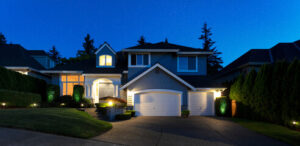Landscape Lighting Repair Is Best Left To The Professionals
As time goes by and the landscape changes, some light fixtures may need to be moved or adjusted. Wire cuts from plants, lawn care specialists, or weather can happen and need to be reconnected.

Like most electrical wiring and connections, lighting problems can get serious if they aren’t fixed on time. Contact Landscape Lighting Repair Orlando for professional help.
When that happens, there could be a problem with the wiring connections or it’s possible that the entire circuit is blown. The fuses inside the transformer, which is what converts 120v to 12v, tend to be pretty reliable but there have been some that have failed completely. That’s a little less common in low-voltage landscape lighting systems but it does happen.
There is nothing worse for a landscape lighting installer than getting a call from a client who reports that their lights aren’t working. Even if the fixtures themselves are working, the entire system can look like a hot mess if the wires are in bad shape. The outdoor environment is rough on landscape lighting wires and it’s not uncommon for them to corrode or get cut.
The most likely issue with the wires is a break at a connection point. That’s especially true of the connectors that are used to join two strands of wire together, which is the most common way that landscape lighting professionals splice the wires in the field. These connectors can be made waterproof by applying liquid electrical tape or using a self-fusing silicone tape. However, the best and most secure option for underground landscape lighting splicing is to use one of these dedicated wire connectors that are designed specifically for buried wire.
These devices provide a tight seal as well as a waterproofed junction. They also make it easier to clean the area surrounding a broken wire. This is important because soil that gets into the break hampers the quality of the splice and introduces moisture into the connection that will cause corrosion.
If you’re trying to troubleshoot a landscape lighting problem, the first step is to check each light with a digital voltmeter. Each halogen light should be receiving 10.5 to 12 volts for proper operation and a consistent appearance. If you get an extremely low reading then it means that something is not reaching the fixture or that there are too many lights on a single circuit. The next step is to try and narrow down the issue by tracing the wires and testing at each location.
Leaks
A well-designed landscape lighting system adds mood and ambience to homes, increases curb appeal for businesses, and makes outdoor spaces more usable at night. But even the most well-designed lighting systems require routine maintenance to stay in peak condition. If not maintained properly, landscape lighting can quickly deteriorate and cause many problems including outages, flickering, and damaged fixtures. Fortunately, there are many things homeowners can do to ensure their landscape lights remain functional.
It’s important to disconnect the electrical source of your landscape lighting before performing any maintenance tasks. This will help prevent any accidental short circuits that could result in damage or injury.
When conducting your maintenance, make sure to remove any plants, dirt or debris that may be blocking light from reaching the fixture. This can improve illumination, help extend the life of your fixtures and, in some cases (especially with older fixtures that give off heat), avoid fire hazards.
While it’s not a problem that occurs very often, sometimes wire connections can corrode. The ground is naturally hostile to buried wires, so it’s important to use products that are built to withstand this environment. This includes using waterproof connectors that are designed specifically for low-voltage underground splices.
One of the biggest reasons low voltage landscape lighting breaks is due to faulty connections. Whether it’s caused by moisture or improper installation, these issues should always be resolved on time as they can cause major damage to your landscape lighting system.
Another common reason landscape lighting repairs are needed is because of a broken ground stake. Over time, these stakes can break from the weather, age or even if you accidentally step on them. This can cause the fixture to fall off the ground and leave a hole in the soil that needs to be filled and repaired.
A good landscape lighting contractor will offer a variety of stakes, so you can find the perfect one to suit your needs. They’ll also provide proper installation so that your lights can be secured in the soil without causing any damage to your property.
Faulty Fixtures
While landscape lighting is much more resilient than your interior light fixtures, it’s still susceptible to a variety of issues. This includes things like a cut line, broken fixture, or faulty transformer. Regular maintenance can help reduce the number of landscape lighting problems and improve the longevity of your system. Some of the most common maintenance steps include checking the power to the transformer, ensuring timer settings are correct, and visually inspecting the entire length of cable for any signs of line breaks or cuts.
Your landscape lighting system will be exposed to sun, wind, rain, and moisture on a daily basis. As a result, it’s not uncommon for outdoor lighting fixtures to develop rust or become frail over time. However, high quality landscape lights that are designed to withstand weather conditions should not show any such signs of wear and tear. If you have any fixtures that appear to be rusted or damaged, it’s important to replace them as soon as possible.
Faulty fixtures can also cause a variety of landscape lighting problems, such as dim or inconsistent lighting. This may be a result of loose connections, voltage drop, or simply a burned-out bulb. In some cases, it is necessary to replace the entire fixture as it’s no longer safe or able to perform as intended.
One of the most common problems with landscape lighting is a faulty transformer. This can occur for a variety of reasons, including improper wiring, a damaged outlet, or an undersized transformer. It’s important to ensure that the transformer is properly sized for your lighting system. This can be easily checked by ensuring that the total wattage of all light fixtures is less than 80% of the transformer’s capacity.
A landscape lighting system requires a significant investment, but it is well worth the effort and expense to keep it functioning properly and aesthetically. To avoid frequent landscape lighting repair, be sure to follow these simple maintenance tips: replace bulbs when needed, use waterproof connectors to protect against moisture damage, clean fixtures and lenses regularly to prevent dirt buildup, and consider upgrading to a more reliable lighting system to reduce the need for frequent troubleshooting and repairs.
Faulty Connections
Landscape lighting adds a beautiful glow to your home and accents landscaping features. However, like anything else, it does require regular care and maintenance to keep it looking its best and working properly. While many issues are easy to repair, there are some landscape lighting problems that are best left to the professionals.
Often, when your landscape lighting fixtures stop working, the first thing you will do is replace the light bulb. If this doesn’t work, you should check the socket with a voltage meter. If the socket has no power, it will show up as open on a voltage meter and won’t allow the light bulb to come in contact with the contacts.
Another common problem with landscape lights is a short circuit. If the total wattage of your landscape lighting system exceeds the capacity of your transformer, it will trip the breaker and your lights will not turn on. This can be a difficult issue to diagnose because it can be very hard to pinpoint exactly where the short is happening. It could be that the wires are touching each other or it may be buried underground and unable to be easily located.
If you suspect that your lighting is shorting out due to a high wattage load, it is important to find and fix the problem quickly. Putting band aids on a system that is not up to par will only lead to more expensive repairs in the future. If your lighting system is more than 15 years old, it may be time to consider a replacement.
Sometimes, the problem is not with your landscape lights themselves but the transformer or connections that run them. The connections within your transformer can become loose over time as you turn the lights on and off. This can cause the lights to not function properly and create hot spots that melt connections or even cause fires. It is important to have all the connections in your transformer regularly checked and tightened.
Oftentimes, this is caused by do-it-yourself kits that use wire piercing connections instead of heat shrink connections, which offer superior weather resistance. In these cases, the copper in the connections corrodes and loosens over time. Using heat shrink and brass connections will help reduce this type of problem.




